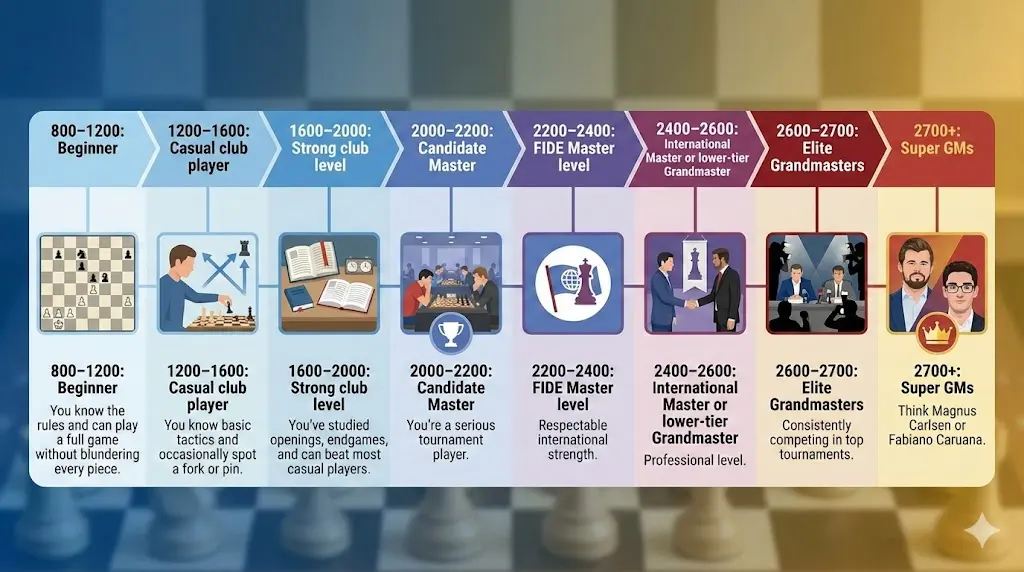If you’ve ever played chess online or followed professional tournaments, you’ve probably seen those mysterious numbers next to players’ names—something like 1350, 2100, or even 2800. These aren’t random digits. They represent a player’s Elo rating, the most widely used system for measuring chess strength.
But what does an Elo rating actually mean? Why does it go up or down after every game? And how do professional players, like Magnus Carlsen or Hikaru Nakamura, use this system to measure their careers? Let’s break it down in plain English.
The Origins: A Professor with a Passion for Chess
The Elo system is named after Arpad Elo, a Hungarian-American physics professor and avid chess master. Back in the 1960s, the U.S. Chess Federation needed a better way to track players’ strength. The older Harkness system was too clunky and inaccurate. Elo stepped in with a brilliant idea: apply statistical models to chess results.
His system was so effective that by 1970, FIDE (the International Chess Federation) officially adopted it for global use. Today, it’s not just chess. Elo-inspired systems measure skill in esports, online games, and even machine learning competitions.
The Core Idea: Ratings Are Predictions
Think of Elo as a prediction machine. It tells you how likely one player is to beat another.
- If two players have the same rating, they should each win about 50% of the time.
- If you’re 100 points higher, you’re expected to win about 64% of games.
- At 200 points higher, your odds jump to around 76%.
That’s the beauty of Elo—it’s not just about what happened in one game, but what should happen over hundreds of games.
How Elo Points Move Around
After every rated game, points transfer from the loser to the winner. The amount depends on two things:
- The rating gap:
- Beat someone much higher rated than you? Big gain.
- Beat someone much lower? Tiny gain.
- The K-factor (basically, how fast ratings move):
- Beginners often have a higher K, so their rating can swing wildly.
- Top GMs usually have a lower K, so they gain or lose only a few points at a time.
For example:
- If a 1500-rated player beats a 1400-rated opponent, they might gain just 10 points.
- But if that same 1500 player defeats someone rated 2000, they could gain 40 or more points in one go.
It’s like poker chips shifting across the table—but with math ensuring the exchanges are fair.
Elo in Action: Online Chess vs. FIDE Ratings
One thing that often confuses beginners is why their rating on Chess.com or Lichess looks nothing like their FIDE rating.
- Chess.com Blitz Rating: A casual player might be 1800.
- FIDE Over-the-Board Rating: That same player could be closer to 1400.
Each platform has its own pool of players, its own K-factors, and its own quirks. That’s why Elo numbers are only comparable within the same system.
Think of it like different currencies. A “dollar” in one country isn’t always worth the same as a dollar elsewhere.
Why Top Players “Farm” Ratings
Recently, Hikaru Nakamura made headlines when he won the Louisiana State Championship against much lower-rated opponents. Critics accused him of “farming Elo”—a tongue-in-cheek way of saying he was picking up easy points against much weaker players.
Here’s why this happens:
- High risk vs. low reward: If a 2800-rated player beats a 2000, they gain almost nothing. But if they somehow lose, they drop a ton of points.
- Selective pairing: In small events, strong players can rack up wins without facing equally strong competition.
To be clear, this isn’t cheating. It’s just a side effect of the rating system. Elo rewards results, not reputation. If you win games, you gain points—even if the opponents aren’t world-class.
This raises a bigger debate: should elite players stick to top tournaments, or is it fair game for them to enter smaller events?
The Elo Ratings Ladder: What the Numbers Mean
So, what does your number actually say about your skill? Here’s a rough guide:
- 800–1200: Beginner. You know the rules and can play a full game without blundering every piece.
- 1200–1600: Casual club player. You know basic tactics and occasionally spot a fork or pin.
- 1600–2000: Strong club level. You’ve studied openings, endgames, and can beat most casual players.
- 2000–2200: Candidate Master. You’re a serious tournament player.
- 2200–2400: FIDE Master level. Respectable international strength.
- 2400–2600: International Master or lower-tier Grandmaster. Professional level.
- 2600–2700: Elite Grandmasters. Consistently competing in top tournaments.
- 2700+: Super GMs. Think Magnus Carlsen or Fabiano Caruana.

For context:
- The average rating on Chess.com Blitz is around 800–1000.
- The highest ever FIDE rating was 2882, achieved by Magnus Carlsen in 2014.
Live Ratings vs. Official Lists
If you’ve ever followed 2700chess.com, you’ve probably noticed players’ ratings shifting in real time. That’s because “live ratings” update after every single game, while FIDE only updates once a month.
This means a GM could technically be No. 1 in the world for a week in live ratings, even if it never shows up in the official list.
Inflation, Deflation, and Why Numbers Drift
One criticism of Elo is that ratings can “inflate” or “deflate” over time.
- Inflation: More players breaking 2700 today than in the 1980s.
- Deflation: Some argue older players lose points unfairly to young rising talents.
It’s like comparing money across decades. A $20 bill in 1980 bought way more than $20 today. Similarly, a 2500 rating in 1990 may not mean quite the same thing as 2500 in 2025.
Elo Beyond Chess
Arpad Elo designed his system for chess, but its impact has spread everywhere. Variants of Elo now rank:
- Esports players in League of Legends or CS:GO.
- Football teams.
- Even AI models in research competitions.
Wherever there’s competition, Elo provides a simple, fair way to measure skill without endless round-robin tournaments.
FAQs About the Elo Rating System
1. What does “Elo” stand for?
It doesn’t actually stand for anything—it’s named after Arpad Elo, the Hungarian-American professor who created the system.
2. What’s considered a “good” Elo rating?
It depends on context. For casual online play, anything above 1500 is solid. In FIDE-rated tournaments, reaching 2000+ means you’re a strong club or regional-level player.
3. Why is my Chess.com or Lichess rating so different from my FIDE rating?
Each platform uses its own rating pool, formulas, and player base. Online ratings tend to be inflated because games are faster and more casual. FIDE ratings are usually lower but more stable.
4. Can my Elo rating ever go negative?
No. The lowest possible Elo rating is typically 100 or 0, depending on the platform. In practice, beginner players start around 1000 on most websites.
5. How often does FIDE update official ratings?
FIDE updates its official rating lists once a month. However, “live” ratings (on sites like 2700chess.com) update after every rated game.
6. Why do grandmasters sometimes lose a lot of points for a single upset?
Because the Elo system is designed to reward unexpected results. When a 2800 player loses to a 2400, the model sees it as a huge statistical anomaly—so the higher-rated player loses many more points than usual.
7. What’s the highest Elo rating ever achieved?
Magnus Carlsen holds the record: 2882, set in 2014.
8. How can I improve my Elo rating quickly?
Play consistently, study tactics, review your games, and focus on avoiding blunders. For beginners, improving calculation and opening knowledge can produce fast gains.
9. Is Elo the only rating system in chess?
Not anymore. Some online platforms use alternatives like Glicko or Glicko-2, which account for rating volatility. Still, Elo remains the gold standard in official chess.
10. Can Elo ratings measure skill in other games?
Yes. Many competitive systems—from esports to table tennis—use Elo-based models to rank players or teams, thanks to its fairness and simplicity.

I’m Xuan Binh, the founder of Attacking Chess, and the Deputy Head of Communications at the Vietnam Chess Federation (VCF). My chess.com and lichess rating is above 2300. Send me a challenge or message via Lichess. Follow me on Twitter (X) or Facebook.

